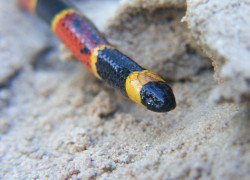
Laura van den Berg’s story “Farewell My Loveds” was published by American Short Fiction and Atticus Review and is included in her story collection What the World Will Look Like When All the Water Leaves Us.
Every writer must learn to create suspense. But how? Laura van den Berg offers a masterful lesson in her story “Goodbye My Loveds.” The story is included in van den Berg’s story collection What the World Will Look Like When All the Water Leaves Us from Dzanc Books and was first published in American Short Fiction and republished by Atticus Review, where you can read it now.
How the Story Works
The story introduces a mystery right away: the hole in the street. But the exact nature of the hole is unclear. Is it bottomless as the little brother believes or simply a hole as his big sister, the narrator, suggests? In delaying the answer, the story not only makes the readers want to know the answer but also changes the readers’ expectations: perhaps the hole really is more than just a hole. In other words, when a story creates suspense, it also creates a suspension of disbelief in the reader.
Here’s a breakdown of van den Berg accomplishes this trick:
- She introduces the mystery (the hole in the street) and a sense of urgency (the brother wakes the narrator up at dawn to look at the hole).
- The narrator and her brother argue about whether the hole is actually a crack.
- The narrator and brother argue about when to use a flashlight.
- The narrator and brother argue about whether the hole is bottomless.
- The narrator imagines her brother disappearing into the hole.
- The characters go back to their apartment.
After each of the first five sections, the story shows us the hole. With each view, we (along with the narrator) see some new aspect of the hole and it becomes a little bigger, deeper, and darker. Here is each view:
- “a dark circle on the asphalt. It was the size of a dinner plate, the borders uneven and jagged”
- “he reached inside, his arm disappearing to the elbow”…’Okay,’ I said, hoping he would stop before a rat found the soft tips of his fingers.”
- “It looked like a patch of asphalt just melted away, a miniature sinkhole precariously close to the rear of a brown Honda…I saw a narrow stream of darkness, as though I was gazing through a telescope trained on a black and starless sky.”
- “He aimed the light into the hole; the beam was swallowed by shadows.”
- “I examined the diameter and, to my relief, decided it wasn’t large enough for him to squeeze through.”
At the end, the narrator imagines her brother falling into it—and this moment introduces a new mystery: why would the narrator imagine such a thing? It is this mystery that will drive the story forward.
The Writing Exercise
Let’s write a small scene around a mystery.
- Choose a mystery. You might use a familiar horror from books/movies. In this story, van den Berg has used the bottomless pit. Here are some other options: pit of snakes, endless staircase, secret doorway, cutout eyes in a painting for someone to spy through, trapdoors, secret passages, monsters under the bed, bogeyman in the closet, stranger hiding in the back seat of the car, and spider under the bedcovers.
- Translate the mystery into familiar realistic setting. van den Berg makes her bottomless pit a pothole. Think about how you could put a secret doorway, endless staircase, or monster into your kitchen or bedroom. Which familiar objects could be made mysterious? Show it to the reader using non-fantastic details.
- Create two characters. One will believe that the mysterious object is truly mysterious, and the other will believe that it’s not. List ways that the first person might investigate the mystery.
- Let the characters argue about the nature of the mysterious object.
- After each investigation or argument, show the object again, with new details, each more mysterious than the last. Your goal is to make the reader appreciate the object in a new way.
Good luck and have fun.




Leave a comment